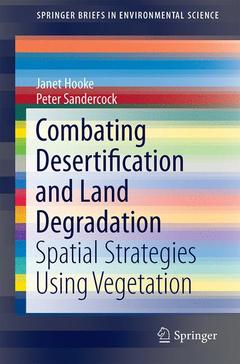Combating Desertification and Land Degradation, 1st ed. 2017 Spatial Strategies Using Vegetation SpringerBriefs in Environmental Science Series
Auteurs : Hooke Janet, Sandercock Peter

Professor Janet Hooke geomorphologist, hydrologist and physical geographer with research interests in catchment processes and dynamics, flood incidence and impacts, connectivity, vegetation-flow interactions; impact of environmental and hydrological changes; catchment and channel management; sustainable management of catchments. Research on sustainable management of erosion and land degradation. Applied projects in coastal processes and sediment systems; sustainable management strategies on coasts.
· International reputation for geomorphological and landscape dynamics research.· Extensive publications on fluvial environments and environmental management.
· 30 years experience of field-based research projects.
· Research Group leader, and director of major research projects
· Chair succession, British Society for Geomorphology 1998-2001, Hon. Sec. 1989-92· On Editorial Board of journals Geomorphology and Catena
· Coordinator of EU project RECONDES examining spatial strategies of mitigating land degradation; production of practical guidelines
· Projects on geomorphological sensitivity and opportunities for channel restoration and flood mitigation of channel instability in Britain and implications for policy; evaluation of strategies for conservation of fluvial scientific sites.
· Research into effects of vegetation in channels and catchments and use in management of erosion and sedimentation in semi-arid lands.
Date de parution : 03-2017
Ouvrage de 135 p.
15.5x23.5 cm



